Group Evaluation of Reading Eggs
Group Evaluation of Reading Eggs
Introduction: What is Reading Eggs?
Reading Eggs is an educational online tool designed to develop children’s reading skills in a fun and engaging way. This gamified reading app focuses on phonemic awareness, vocabulary development and reading comprehension for children ages 2-13.
A brief walk through of the app/how it motivates appropriately aged children

Step 1: Beginning with a placement test allows students to enter at a level that is best suited for them. This is a key feature as it avoids initial boredom/discouragement. When students begin at a level that they can be successful in, it provides them with a sense of confidence that “is tied intimately to success” (Gurthrie, 2011, p.178,), whereas, “students who struggle begin to doubt their abilities” (p.179) and therefore “report declines in self-efficacy for reading” (p.193).

Step 2: Reading eggs is a self-paced learning app which allows students to pause, re-do or proceed as they please (interactivity effect). This sense of self-direction has been proven to increase a child’s motivation to read (Gurthrie, 2011, p.180). Furthermore each activity is designed as a game and the information that is being taught is reiterated multiple times throughout each game to increase retention (redundancy principle).
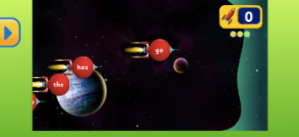
- In this example, players are asked to tap all the rocket ships that have the word “go” on them as they fly through the air. This design is engaging for young learners (as it simply feels like a game).

Step 3: Not only does this app have games/activities to increase reading skills, but it also offers other engaging materials such as a reading library. Students choose books that interest them (which increases intrinsic motivation). Although rewards are initially useful when introducing reading to children, “extrinsic rewards do not motivate reading achievement in the long term” (Guthrie, 2011, p.178), and therefore, providing children with choice and and topics that are relevant to their lives/interests increases intrinsic motivation, which in turn increases retention (p.183-188).
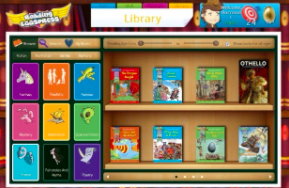

Step 4: Parents can track their child’s progress regularly on the app and through periodic emails updates. Additionally, Reading Eggs has a ‘teacher dashboard’ to keep track of each student’s progress (which fosters the integration of Reading Eggs in a classroom and/or at home reading program).
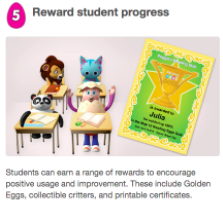
Step 5: Reading Eggs rewards students for their progress. While extrinsic motivation may not be the solution long term, rewards get children excited about an activity and serve as a great “jump start” to get students interested in reading (Gurthrie, 2011, p.178).
Case Study
While Reading Eggs is designed to feel entirely like a game, research shows that the app significantly improves overall reading skills. In 2017, Latisha Lowery conducted a study to see how effective regular use of Reading Eggs was on student’s reading proficiency levels. The study was done in a rural community where 32% of the students lacked phonetic awareness and/or comprehension skills (Lowery, 2017). The school decided to introduce Reading Eggs as part of their intervention program (in combination with teacher support). The students who participated in this study were in grade two, chosen at random, and were split into two test groups. Class A would each spend 30 minutes on Reading Eggs a day, complete with weekly reports tracking their progress, and had teacher instruction along the way. The second group, class B, did not use Reading Eggs and solely relied on teacher instruction. The results showed that Class A demonstrated growth and the amount of students reading below grade level decreased by 19%, and the amount of students reading above grade level increased by 6% (Lowery, 2017). It should be noted, however, that while the use of this app was clearly effective, Reading Eggs should not supplement teacher instruction entirely. Namely, it should be used as a tool in the classroom to help improve both phonetic and comprehension skills. The school continues to use Reading Eggs as part of their intervention program.
A Teacher Review of Reading Eggs – Barbara Petersen’s First Impressions
- After walking through the app with Barbara Petersen (a Vancouver Island Kindergarten- Grade 3 teacher), this what she had to say:
- Well organized and easy to use
- Can be a bit cartoonish (good for younger learners)
- Repetitive, but in a positive way, that would hold the child’s interest
- Likes the practicing typing aspect
- Impressed with the use of music
- Impressed with the pronunciations of phonetic sounds
- After walking through the app, Barbara says she would feel comfortable recommending this app to Kindergarten and Grade One students. She also believes it is a fun and engaging way for students to practice reading at home. She also states it would be a good addition to the at home aspect of a reading program.
A Parent Review of Reading Eggs
Which Multimedia Principles does Reading Eggs Contain?
When evaluating Reading Eggs based on the Cambridge Handbook of Multimedia Learning, it is evident that it is a useful educational tool to incorporate in the classroom as it follows many of the multimedia principles discussed in the handbook.
Feedback Principle:
Reading Eggs provides users with immediate “correct” or “incorrect” feedback. The app also does a good job of summarizing the information and learning that the learner has completed at the end of the lesson which guides the user to understand the overall important aspects of the lesson. This being an example of explanatory feedback whereas the program “provides the learner with a principle-based explanation of why his or her answer was correct or incorrect” (Mayer, 2014, p.450).
Redundancy Principle:
The app provides a variety of learning games and activities for each lesson which allows students to obtain identical information in diverse ways (Mayer, 2014, p. 248).
Multimedia Principle:
Throughout the app, there is use of images, words, text, music, and auditory instructions that are used to teach concepts to and engage the learner (Mayer, 2014, p.175).
Coherence Principle:
A limitation of this app is its neglect for the coherence principle. The coherence principle states that “people learn more deeply from a multimedia message when extraneous material is excluded rather than included” (Mayer, 2014, p. 279). However, as the issue with disobeying this principle is that added information has the potential to hinder one’s learning rather than nurturing it (Andrade, 2013). Reading Eggs does however, have the element of “fun” and “fantasy” which in theory and practice, is shown to have positive effects on learning by making the material and educational activities more intrinsically moving for students (Parker, 1992).

How Reading Eggs Supports Multimedia Learning at Home
When it comes to literacy, school is not the only place students can learn important skills. Especially in their early years students need access to tools and activities that can help them become better readers and writers in the future. It is important that caregivers parents and guardians encourage activities that help students learn literacy skills at home as studies have found that “home literacy activities such as writing, storybook reading, and identifying environmental print positively influences emergent literacy.” (Neumann, 2016) In today’s evolving world, technology is more prevalent than ever, meaning many of the literacy activities students will take part in are run through apps. This is where Reading Eggs comes in, through engaging activities students to build their literacy skills at home, something we now know is particularly important. And uUsing technology to build literacy skills will only aid and not hinder students’ literacy when not using technology as “children were observed to transfer their developing knowledge of letter and sound relationships and word spacing between these tools. This illustrates that young children are capable of using digital and nondigital tools for literacy learning.” (Neumann, 2016)
References:
Andrade, G. (2013). Coherence Principle Analysis. GregAndradeEdTechLearningLog. https://gregandradedesign.wordpress.com/edtech-513-projects/coherence-principle-analysis/
Guthrie, John T. (2011).Best Practices in Motivating Students to Read. Best Practices in Literacy Instruction.(4th ed.), p.177 – 194.
Lowery, Latisha D. (2017) Effects of Reading Eggs on Reading Proficiency Levels. University of South Carolina Scholar Commons. Retrieved from https://scholarcommons.sc.edu/cgi/viewcontent.cgi?article=5160&context=etd
Mayer, R. (Ed.). (2014). The Cambridge Handbook of Multimedia Learning (Cambridge Handbooks in Psychology). Cambridge: Cambridge University Press. doi:10.1017/CBO9781139547369
Neumann, M. M. (2016). Young children’s Use of Touch Screen Tablets for Writing and Reading at Home: Relationships with Emergent Literacy. Computers & Education. 97, 61-68. https://doi.org/10.1016/j.compedu.2016.02.013
Parker, L. (1992). Effects of fantasy contexts on children’s learning and motivation: Making learning more fun. Journal of Personality and Social Psychology. US: American Psychological Association, 62(40), 625-653.
Remix of Chapter 9: The Modality Principle in Multimedia Learning
Remix of Chapter 9: The Modality Principle in Multimedia Learning
What is the modality effect?
The modality effect refers to a cognitive load that appears when partially auditory and partially visual presentations of information work together to be more effective than when a single modality is used to present information.
How does this theory affect teaching?
The modality effect is associated with the dual coding theory and the model of working memory and can be explained by the cognitive load theory. The working memory has a small capacity (it holds 5-9 pieces of information, only processes 2-4 and can only hold on to this information for about 20 seconds). Therefore, teaching methods are ineffective when they ignore this theory as it may overwhelm students’ cognitive loads.
How can we teach effectively with this in mind?
There are three things to remember when designing instruction using the modality principle:
- The material being presented should be essential
- What is being shared is should not be redundant (both auditory and visually)
- Information is complex enough that techniques to reduce cognitive load are necessary
*It should be noted that research has found that verbal information given orally in small fragments along with any other visual information is effective. On the other hand, long and complex verbal information is difficult to hold in working memory, therefore it should be shown visually.This will be discussed more in further sections of the remix (see transient information effect).
How does the working memory function?
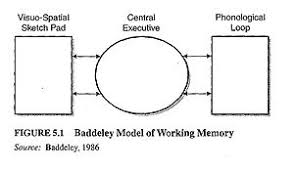
Baddeley and Hitches three-component model of the working memory aligns with the idea that there are different processors for visuo-spatial and language based materials. The model contains a central executive which then divides into two components. The visuo-spatial sketchpad processes information in a visual and spatial form (such as colour and movement) whereas the phonological loop processes text and auditory material.(Low & Sweller p.229, 2014)
Dual motive presentation in the classroom:
Research shows that dual mode presentation can result in increased performance on both memory tasks and monitoring tasks (Low & Sweller, p. 232, 2014). This is due to the fact that there are separate processors for visual and auditory information (see diagram above) in the working memory. Therefore, it should be theoretically possible to see greater retention of information when the modality effect is obtained. Namely, in the classroom, student academic performance can be enhanced by dual mode presentation techniques.
How the split attention effect affects student learning:
The split attention effect is when information must be processed in two or more ways simultaneously in order to be understood. For example, in mathematics, the split attention effect occurs when students must refer to a text and a diagram at the same time in order to solve a problem. In other words, neither the text or the diagram alone convey enough information for the student to solve the problem. Therefore, by going back and forth between the diagram and the text, the brain is forced to memorize too much information at once and that the mental energy required to integrate the two different sources of information hinders learning (Low & Sweller, p. 235, 2014). Low and Sweller propose a more efficient way to integrate two sources of information, which is called the integrated format (p. 235, 2014). This is when the text and the image (or diagram) are combined and do not require students to flip back and forth between the two, which in turn, facilitates learning (see classroom example below). This is crucial to keep in mind when creating visual powerpoints, textbooks, worksheets and assigning homework pages.
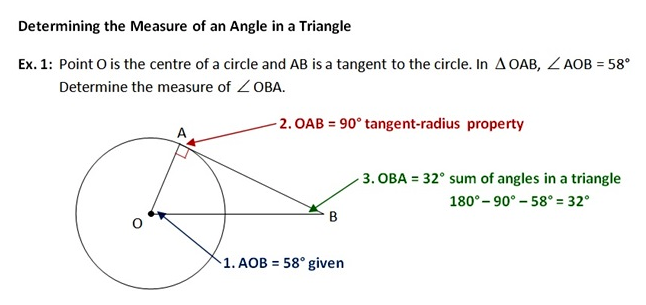
Another take on the modality effect:
While many studies demonstrate the modality effect, there are some studies that contradict this theory (proving a reverse-modality effect). Tabbers and Van der Spoel’s study in 2011 concluded that when learning is self-paced and visual only instructions are provided there is a higher success rate. They argue that self-paced instruction allows one to transfer information from the working memory to the long-term memory more easily. An outside study, “The modality effect tested in children in a user‐paced multimedia environment” by M.J. Witteman and E. Segers conducted in 2010 also concluded that in self-paced settings there is a reverse modality effect. In this case, a sample of primary school students (around grade 5) actually learned better solely through visual instruction (text and images) when they were able to learn at their own pace (Witteman and Segers, p.1, 2010). This is important for educators to consider when teaching by distance (i.e. homeschooling/online schooling).
In most cases where studies failed to demonstrate the modality effect, it was because the audio or visual materials were far too complex and/lengthy and therefore overloaded the working memory. Leahy and Sweller believe that because spoken information is momentary, it can easily be forgotten and therefore there may be no advantage to portraying new complex information in this form (Low & Sweller, p. 239, 2014). This is called the transient information effect (Low & Sweller, p. 240, 2014). Overall this demonstrates that there are many variables to consider as an educator, and that the modality effect is not always found.
In an era of predominantly online instruction (due to the global pandemic), it is important to consider how this new way of teaching may cause a reversed modality effect. An article titled “The reverse modality effect: Examining student learning from interactive computer‐based instruction” by Fethi A. Inan, Steven M. Crooks, Jongpil Cheon, Fatih Ari, Raymond Flores, Murat Kurucay and Dmitrii Paniukov in 2013 also proved a reverse modality effect. Inan et al. conducted a study that concluded that students who are taking courses online learn better through written instruction than through audio and text instruction. As mentioned above, this may also be due to the transient information effect (Low & Sweller, p. 240, 2014).
How to achieve expansion and enhancement of the working memory?

Information is processed the best when the working memory is expanded to take in the total load of information. This can be supported through the dual coding theory and the split attention and interactivity effects (although there are some exceptions). When it comes to deciding how to present text, research has proven that a visual diagram combined with auditory text increases the working memory capacity because the information is split and relies on both parts of the memory for processing. This ties in with the dual coding theory, which activates both processors (which then strains, but does not overload the working memory). The result in an outside source by Wouters, Paas, and Merriënboer’s, states that “accompanying complex visual materials with written explanations may result in too much load on the visual channel and thus to inferior processing of the instructional materials” (Wouters, Paas & van Merriënboer, 2009), proving again that a visual diagram in the classroom with presented text may result in more successful student learning outcomes. Experienced learners may be an exception to this theory as they may learn best with a diagram alone. This also supports the notion of differentiated instruction within the classroom (Sousa and Tomilson, p.36 2018). The interactivity effect also plays a role in the expansion of the working memory, proving that high element interactivity materials alongside auditory/verbal instruction, enhances the modality effect and the ability to retain information (Low & Sweller p.238, 2014). Although, exceptions arise when either the auditory information or materials are redundant to one another. For materials with auditory instructions to be effective, they must follow the split attention principle (noted above).
Conclusion:
Our remix has proven that the modality effect is highly dependent on the cognitive load of instructions. If instructions overload the working memory (such as long, highly complex or unfamiliar information) then learning is hindered (regardless of how the information is portrayed). These factors are very important for educators to understand when preparing lessons and materials. Because the modality effect is not entirely black and white, we can not simply focus on presenting information in two different forms, but we need to also consider how much information is being provided, what information is being provided and how it is being provided (i.e. the transient information effect).
References:
Inan, F.A., Crooks, S.M., Cheon, J., Ari, F., Flores, R., Kurucay, M. and Paniukov, D. (2015), Multimedia design principles. Br J Educ Technol, 46: 123-130. doi:10.1111/bjet.12129
Low, R., & Sweller, J. (2014). The Modality Principle in Multimedia Learning. The Cambridge Handbook Of Multimedia Learning, 2, 227 – 243.
Sousa, D., & Tomlinson, C. (2018). Differentiation and The Brain (2nd ed.). Bloomington, IN: Solution Tree Press.
Witteman, M. and Segers, E. (2010), The modality effect tested in children in a user‐paced multimedia environment. Journal of Computer Assisted Learning, 26: 132-142. doi:10.1111/j.1365-2729.2009.00335.x
Wouters, P., Paas, F., & van Merriënboer, J. (2009). Observational learning from animated models: Effects of modality and reflection on transfer. Contemporary Educational Psychology, 34(1), 1-8. doi: 10.1016/j.cedpsych.2008.03.001
Group Evaluation! (what app we chose & why)
In a Facebook messenger group call, each of our pod members pitched our chosen interactive multimedia apps to the group with the hope in mind that one of our apps would stand out to the rest of us. Sam introduced us to the video game-style app called “Prodigy”. From the get-go, we were all very interested in hearing more about the wizarding world of math games because most of us had never seen or heard of this app before. What stood out for us the most was how the app seemed to be entirely a video game with the learning portion hidden within.
The next app to be introduced was “Khan Academy Kids” proposed by Kirby. All of us had heard about the parent software of the app “Khan Academy” but some were surprised to hear about the kid’s version of the widely known educational tool. Kirby explained the fun elements of the app and how it was constructed to provide a personalized learning experience for preschool children. What stood out the most to the group was that the app could be specifically configured by the parent or teacher to suit the learner and their level.
Alison next, introduced her chosen multimedia app “Duolingo”. We had all heard about Duolingo but were very surprised to hear that there were many statistics and scientific studies shown on the effectiveness of the app, and how the app is proven to increase the learner’s language ability. One study Alison showed us stated that “It would take an average 26-49 hours of study on Duolingo to cover the material for the first college semester of Spanish”. We were all pretty amazed and shocked by this information especially by the fact we had all spent hundreds of dollars on a language course in the past.
The last app pitch came from Lauryn introducing us to “Reading Eggs”. As none of our pod members had heard about Reading Eggs before Lauryn we were automatically intrigued. Lauryn explained to us that she had come across Reading Eggs when she asked her elementary teacher mom about some of the educational tools and apps she and her colleagues were using as school was out of session. Reading Eggs is a reading program that specializes in phonics, meaning, fluency, and comprehension skills. The app is versatile in the way that it is available on virtually every platform, has the ability of a personalized learning journey through a placement test, and overall has very well-rounded multimedia and interactive learning experience for the learner.
After more talk about the four choices of apps, we based our decision off of seeking away from the known. Khan Academy (kids or not) we all had much experience with as well with the language app Duolingo where we had all met the green owl. So that leads us two choices, Prodigy, the magical math game, or Reading Eggs the colourful reading journey. We ended up deciding to go forward with Reading Eggs. The main reasoning behind this choice is that we felt the world of apps and programs is predominantly dominated by mathematics apps and games and that reading ones are hard to come by, especially ones that have research backing them up in effectiveness. Based on this we were all on board to discover more about Reading Eggs and the effectiveness, history, and research behind the app.
Blog #3 – App Review
The app I chose to evaluate is Reading Eggs. It is a reading program designed to support students learning to read from ages 2-13, and is available for all different platforms – android, google, and apple. The app offers four levels for students – reading eggs junior for pre-literacy learners, reading eggs for beginning and emerging readers, and reading eggspress for reading for meaning, fluency and comprehension skills. Upon making an account on the app, the user may chose their level (assigned by teacher or parent/guardian), or they may choose to take a placement test. The app then uses your level of reading to provide games, interactive videos, and books to read. (Newbridge 2020)
In regards to the learning principles of multimedia, Reading Eggs provides a well rounded multimedia experience. In the level of reading I chose, reading eggs, the app was very interactive – throughout the videos, there was opportunities to click on the correct answer, match the letters, as well as activities after the video to summarize the information. With the redundancy principle in mind, the app did well at providing a variety of games that had differences, so it didn’t feel as though the same information was being told more than once, instead more information was added, and different functions were added to enhancing the learning experience. Many of the activities included pictures and words (matching and reading), which aligns with the modality principle. The one thing I did find was that the app did contain components that were irrelevant to what the user may be learning, such as travelling through the different levels, and some mini games included in the app, however, I think this was most liking done on purpose to engage student, and give the app a game like feel.
Here are some screen shots from Reading Eggs.
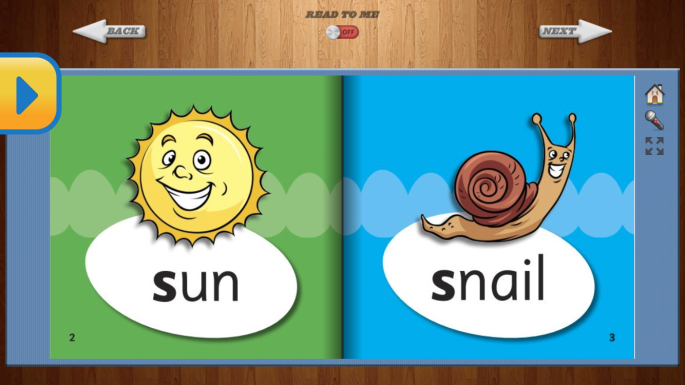
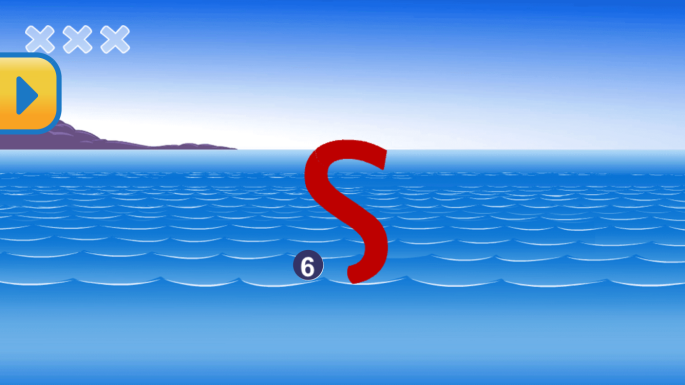
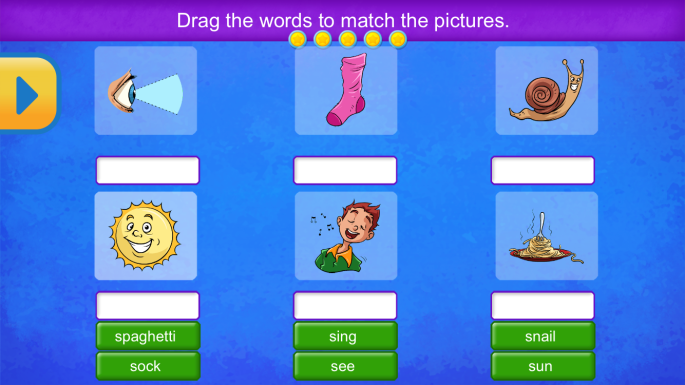
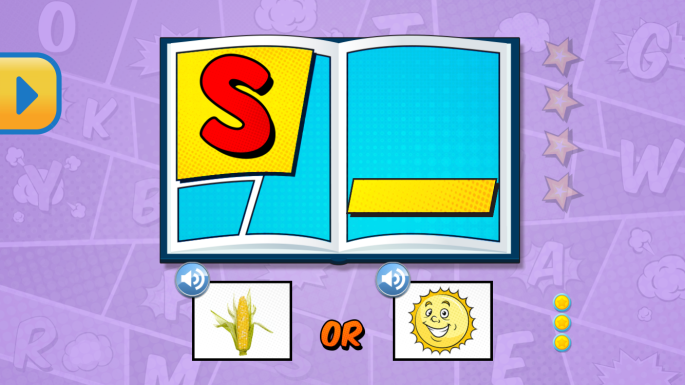
I would classify Reading Eggs as an Augmentation tool. The app provides “significant enhancements to the student’s experience” (H.L, 2017) by providing an exciting and interactive way to practice reading. Although I do believe, the information presented within the app could be replaced by a traditional approach, the app does offer differentiation for learners, by providing the opportunity for students to work on independently, on their own reading level, at their own pace. I could see this app working in the classroom during silent reading time, centres, a pre-lesson activity, or even a part of the classroom’s reading program, as students could play this at home, given they have the technology to support it.
Evaluation of the App:
Functionality: This app is designed for one user at a time, can accommodate an entire class if each student had a device to work with. It may also work with one device to one small group, or pair of students with a similar reading level. The app is very user friendly, and easy to explore, and learn through the activities. While using the app, I did not see an option for help or tech support, but that is available if you look up their phone number.
Accessibility: The app has considered diverse learners through its platform, and provides lessons that could work for many if not all types of learners. The app does not require any access equipment. The cost of the app is $9.99/month, but upon signing up there is one free month of use.
Technical: Students may use Reading Eggs via any, up to date operating system, or browser, and their are no additional downloads.
Mobile Design: The app can be accessed on any up to date device or browser. There is no functionality of the app without wifi.
Privacy, Data, and Protection, and Rights: Reading eggs does require an account, but can be complete with an email, and first and last name.
Social Presence: Reading Eggs can be used by individual users as well as classroom use. It does provide the opportunity of interactivity between users as students can read books together.
Teaching Presence: Reading Eggs allows teachers to make an account that they can share with their students. The teacher can then access the students work, progress, and activity on the app. The teacher will also receives student updates via email. The app is customizable, as it allows for readers of all levels to participate, and provides a variety of levels to complete work and read.
Cognitive Presence: I believe reading eggs does help to develop reading skills, but could not be used to replace a lesson. This would be a great addition to a classroom’s reading program, or centres. Learners are able to receive feedback through the app.
References:
H.L, . (2017, October 30). SAMR Model: A Practical Guide for EdTech Integration. Schoology Exchange. Retrieved from https://www.schoology.com/blog/samr-model-practical-guide-edtech-integration
(2020). Ipad Apps: Reading Eggs and Reading Eggspress. Retrieved 18 June 2020, from https://www.newbridge-academy.ca/post/ipad-apps-reading-eggs-and-reading-eggspress
Blog #2 – Video and Recording Response
With this weeks’ video and voice recording, I feel like I have a much better grasp on what multimedia learning looks like. Not only that, but I feel more confident when it comes to assessing and deciding whether to use a certain multimedia tool. The principles of multimedia learning that Kevin Alexander talked about in his recording, about how processing for multimedia learning works, made me more prepared for when I want to present, teach, and evaluate or assess tools. Learning about the three processes that occur (extraneous, essential, and generative) helps me to understand both myself as a learner, as well as the students I work with. While using multimedia learning, I want to strive to look at how it is designed, and whether it would be the best fit for my students, using these principles as a guideline.
In Dr. Ray Pastore’s video, multimedia learning was thoroughly discussed and explained, leaving me with a strong understanding of how it works, and what to be mindful of while using multimedia to teach. I resided with many of the principles he talked about, and found myself thinking back on different learning experiences I’ve had, and how these principles played a role. The interactivity effect was the one that stuck out most for me. The lessons I usually enjoy most, are ones that are interactive – whether that be connecting the information through storytelling, a demonstration, or an activity where students can apply and practice the information they are learning. Earlier today, I recertified my first aid, and while hearing about this principle, I was thinking how ineffective a first aid course may be if there were no interactive components – like practicing on the manikins, being given a scenario, or being asked thought provoking questions. I think activities like these allows us to process the information, as well as give us a greater opportunity to remember it long term. A couple of years ago, when I was in studying sciences, I remember the professors always having the notes on screen, and while they were going through the slides they were also reading them out to the class. I would notice that majority of the class would write notes while this was happening, but I remember just listening because I knew I wouldn’t be able to remember what the prof was saying if I was scrambling to copy down the notes that were on the screen. Instead, I would sit back and listen in the lectures, and jot a few notes down from what they were saying but then refer to the slides after to write notes and study. I didn’t realize this then but I understand now that this would fall under the redundancy principle, which states it is presenting the information two times can interfere with learning, as well as increase cognitive load (Pastore 2008). Overall I found this video to be very educational, and helped me to understand why and how a multimedia design for learning works.
I did find it interesting how Dr. Ray Pastore didn’t follow each of the principles for multimedia learning in his video. For example, there wasn’t many cues that made us aware of important information (such as bolding, arrows, and larger text) which would be the signalling principle. I also noticed that the video didn’t follow the redundancy principle that presenting the information twice can interfere with learning (Pastore 2008). I did however find that the ability to pause, play, and rewind very helpful while making my sketchnote (see below) which does align with the interactivity effect. I do, however think Dr. Ray Pastore made a very clear and concise video explaining multimedia learning, even though he may have disregarded a few principles.
Here is my attempt at sketchbooking!
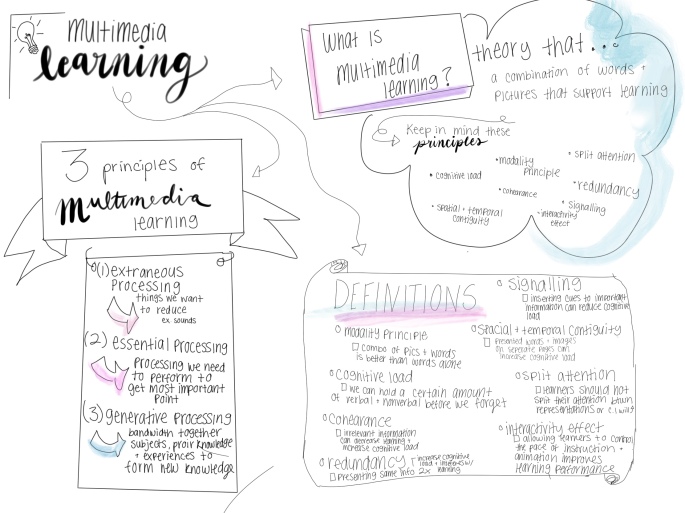
References:
Pastore, R. (2018). What is Multimedia Learning? What is Multimedia?. Retrieved from https://www.youtube.com/watch?time_continue=4&v=g-sknUVq1mk
Blog Response – Kirby
Kirby’s Blog: https://kirbyseducationjourney.opened.ca
Hi Kirby! Thanks for sharing your perspectives and curiosities about interactive and multimedia learning. You provided some interesting questions that I too would also like to explore. Your perspective on multimedia learning for students who have visual and/or auditory impairments, made me wonder what multimedia learning would look like in these cases. Because multimedia does include sensory modalities, I think other senses outside of auditory and visual could be used, such as touch. I have seen communication apps for nonverbal students where they see images to choose from, and let’s say they pick an image (a person waving) and then a word written on the bottom (“hello!”), and when they press it, they are communicating through the app, hello! This would be multimedia learning as it touches on sight, touch, and sound!
I hadn’t thought much of subtitles before, but I am enjoying reading these blogs and finding out new multimedia tools. I can understand how they helped you to understand what is happening, and I agree with your point of how they provide the audience with a complete comprehension of the story. Also, thank you for providing that article you found on the benefits of subtitles, it was a very interesting read!
Looking forward to reading your future posts!
Blog Response – Sam
Hey Sam! Thanks for your explanation of interactive and multimedia learning in your first paragraph, made it easier to understand! It is interesting how they sound unfamiliar, but have been used as an educational strategy for centuries.
The interactive cooking and baking class you took sounds fun yet educational in helping you with math in a creative way! I can see how working through a recipe helped you to get a better understanding of fractions, as baking/cooking would be using fractions in a concrete and hands on way. Also, the video you provided went along well with what you had discussed earlier with measurement and conversions! After watching, I feel inclined to include recipes and baking when I am teaching math. I am happy you left the class feeling more confident with math concepts, while learning a new life skill.
I agree with your last statement in that multimedia and interactive learning approaches may be more inclusive as they can account for a wider range of learners! It is something to keep in mind while creating lesson plans, and activities.
Blog Response – Alison Junger
Alison Junger: https://alisonjunger.wordpress.com/2020/06/07/blog-post-1/
Hey Alison! I enjoyed reading your blog about multimedia and interactive learning! I too had the initial thought that multimedia learning only existed in the digital world, and it was interesting to find out as you put, that it is “not uniquely technology centered”. I think the expectations you’ve set for this course are very reasonable, and I hope we are both able to leave with new strategies for how to incorporate multimedia, and interactive learning in our classrooms.
Rich’s example of his son playing Pandemic 2, is very powerful! I would love to be able to incorporate games into my classroom as well. I like the comment you made about how children will talk about games endlessly with their peers, as I have also seen this happen! Your idea of incorporating the use of online games in your classroom is great, and I feel like now there are many games that have the potential to provide learning opportunities. I always think of that lab we had where we used minecraft as a tool to teach survival skills!
It sounds like you are very interested, willing, and excited to learn more about incorporating technology in the classroom!
Multimedia and Interactive Learning
Multimedia Learning can be offered in a variety of ways, and exists beyond the digital world. The theory of Multimedia learning was developed by Richard Mayer, and it is when words and images are combined to create lasting, and memorable learning outcomes. Some examples of multimedia learning could be power-points, modern textbooks, and more! When I was in Grade 9, I switched schools and I was able to continue math but at a year above my grade level. The only problem was that since it was a middle school, and grade 9 was the last year offered, I had to do math online through correspondence. I struggled with not having a face-to-face teacher to answer my questions, and walk me through major concepts. This is when I discovered Khan Academy (https://www.khanacademy.org/), a great online multimedia learning tool, that combined voice with images and diagrams to explain to and guide the learner through different topics. Overall this had a great impact on my understanding, and I felt more confidence while completing new assignments. Using the multimedia principle in my learning helped me to complete my online course, while providing an enriching learning experience. I think what was the most impactful of this tool, was its simplicity in the language used to explain, and the fact it was a video that you could watch over and over to gain a better understanding.
While reading the article, The Hidden Importance of Teaching With Stories, I learned how storytelling allows us to make connections, and was reminded why storytelling should and can be used as a teaching tool in all subjects. Stories enrich learning by allowing opportunities for connections to be made, while allowing students to absorb more material at hand, which creates stronger learning outcomes. After reading this article, I was reflected on an impactful learning experience through story, that happened last year when we had a Indigenous Ways of Learning workshop, where we were taught bark biting. The guest speaker, prior to, and during, told us the story of how she was taught bark biting when she was young, and during the story she instructed us how to do it. This created a meaningful, and memorable learning environment, and allowed us to learn about bark biting, and indigenous culture through story and hands on experience at the same time. How she embedded the story within the teaching was thoughtful, and allowed us to connect to one another while completing the activity.
Overall, I think multimedia and interactive learning, are how all lessons should be taught. As they have a learner-centred approach, and are beneficial to the students when it comes to understanding, building and making connections, and fosters a greater desire to learn.



